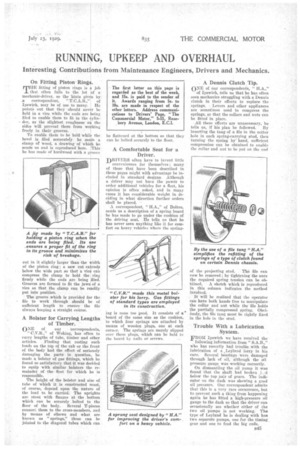RUNNING, UPKEEP AND OVERHAUL
Page 71

If you've noticed an error in this article please click here to report it so we can fix it.
Interesting Contributions from Maintenance Engineers, Drivers and Mechanics.
On Fitting PistonRings.
THE fitting of piston rings is a job that often falls to the lot of a mechanic-driver, so the •hints given by _a correspondent, " T.C.A.B.," of Ipswich, may be of use to many. He points out that they should never be held in a vice while the ends are being filed to enable them to fit in the Cylinder, as the slightest roughness on the sides will prevent them from working freely in their grooves.
To enable them to be held while the bevel is filed accurately. he made a clamp of wood, a drawing of whiCh ho sends us and is reproduced here. This he has made of hardwood with a groove A jig made by "T.C.A.B." for holding a piston ring when the ends are being filed. Its use ensures a proper fit of the ring in its groove and minimizes the risk of breakage.
cut in it slightly larger than the width of the piston ring; a saw cut extends below the wide part so that a vice can compress the clamp to hold the ring firmly while the ends are being filed. Grooves are formed to fit the jaws of a vice so that the clamp can be readily put into position.
The groove which is provided for the file to work through should be of sufficient length to ensure the file always keeping a straight course.
A Bolster for Carrying Lengths of Timber.
ONE of our correspondents, " C.V.R.," of Woking, has often to carry lengths of tube, timber and other articles. Finding that resting such loads on the top of the cab or the front of the body had the effect of seriously damaging the parts in question, he made a bolster of gas fittings, which he found so satisfactory that it was decided to equip with similar bolsters the remainder of the fleet for which he is responsible. The height of the bolster and size of tube of which it is constructed must. of course, depend upon the nature of the load to be carried. The uprights are stout with flanges at the bottom which can be securely bolted to the floor of the body. Several T-pieces connect: them to the cross-members, and by means of elbows and what are known as "springs," these can be jointed to the diagonal tubes which can be flattened at the bottom so that they can be bolted securely to the floor.
A Comfortable Seat for a Driver.
DRIVERS often have to invent little conveniences for themselves; many of those that have been described in . these pages might with advantage be included in standard designs. Although a driver may not have the power to order additional vehicles for a fleet, his opinion is often asked, and in many cases it has considerable weight in deciding in what direction further orders shall be placed. A correspondent, "HA.," of Bolton, sends us a description of a spring board he has made to go under the cushion of the driving seat. He tells us that he has never seen anything like it for comfort on heavy vehicles where the spring jug is none too good. It consists of a board of the same size as the cushion, to which four springs are attached by means of wooden plugs, one at each corner, The springs are merely slipped over these plugs, which can be held to the board by nails or screws. ONE of our correspondents, " FLA.," of Ipswich, tells us that he has often seen mechanics struggling with a Dennis clutch in their efforts to replace the springs. Levers and other appliances are sometimes used to compress the springs, so that the collars and nuts can be fitted in place. All these efforts are unnecessary, he tells us, if his plan be followed,' By inserting the tang of a file in the cotter hole in each spring-carrying stud, then turning the spring by' hand, sufficient compression can be obtained to enable the collar and nut to be put on the end of tine projecting stud. The file can now be removed ; by tightening the nuts the required spring tension can be obtained. A sketch which is reproduced in this column indicates the method involved.
It will be realized that the operator can have both hands free to manipulate the collar and nut while the file holds the partially compressed spring. Obvi
• Zusly, the file tang must be tightly fixed in the hole in the stud.
Trouble With a Lubrication System.
FROM Ipswich we have received the following information from " S.A.B.," who has recently had trouble with the lubrication of a .Leyland lorry in his care. Several bearings were damaged throUgh lack of oil, although the oil pressure gauge was working correctly.
On dismantling the oil pump it was found that the shaft had broken below the top pair of gears. The indicator on the dash was showing a good oil pressure. Our correspondent admits that this is a very rare occurrence, but to prevent such a thine' from happening again he has fitted a high-pressure ail gauge to the dash so that the driver can occasionally see whether either of the two oil pumps is not working. The type of Leyland he is dealing with has two separate pumps, one for the timing gear and one to feed the big ends.




















































































































